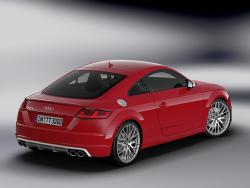 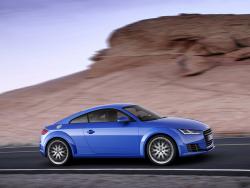 2015 Audi TT. Click image to enlarge |
Preview and photos by Lesley Wimbush
Ingolstadt, Germany – First debuted as a concept car at the 1995 Frankfurt Auto Show, the Audi TT owes its name to the British Isle of Man TT (Tourist Trophy) motorcycle race. Back in 1911 a company called NSU began a successful campaign in the TT race, and when they later merged to become Audi they paid homage by giving the designation to their new sports car.
The sun has just begun its descent as we walk across the vast courtyard and into the Audi mother ship known as “The Forum”. Like the other top German luxury brands, Audi provides full-on customer service for those who prefer to pick up their vehicles at the source and even arranges for them to be shipped back home – wherever that may be. The Forum is immense: as large as the principality of Monaco, and it includes restaurants, a museum and guided factory tours.
Through a farcical series of events that began with an apocalyptic snowfall, a plane that wouldn’t de-ice, a malfunctioning engine valve and finally, a missing flight crew – we were more than seven hours late for the presentation on Audi’s latest version of their now iconic sports car. Impending dusk lends an otherworldly glow to the glass complex; factor in sleep deprivation and the entire scene becomes a bit surreal.
Fortunately, several of the car company experts graciously agreed to remain and re-stage most of the presentation on the car that is largely credited with turning Audi into a “design brand” and greatly boosting their image.
Inside the ethereal white recesses of the Forum’s main building, we’re introduced to the TT lineup, beginning with the original TT that appeared in 1998.
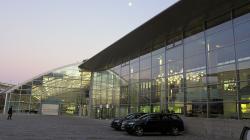  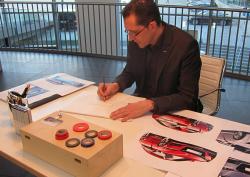 The Audi Forum & Audi designer Jürgen Löffler. Click image to enlarge |
Designer Jürgen Löffler pointed out the car’s various distinguishing attributes: a three box design with the cab simply placed on top, rounded yet muscular haunches and the overall circular theme – from fuel filler, wheel arches, side mirrors right down to interior features like air vents. An instant hit, the first-gen TT was a departure from anything Audi had produced to date, despite the fact that it really didn’t handle all that well. Based on the Mk IV Golf platform, the TT did somewhat resemble a Beetle, and was later criticized as being a “chick car” for its softly rounded curves.
Gesturing at the second-gen TT, Löffler described it as “more integrated into the Audi family” and a “step in the right direction to make it sportier”. Sharper and more modern, the second-generation model was also lighter and much quicker. The more aggressive design, better handling and additional power were transforming the TT from design icon into genuine sports car.
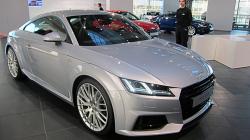 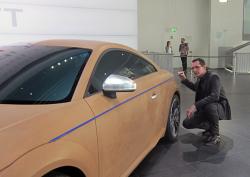 2015 Audi TT. Click image to enlarge |
Walking us over to the new TT, the third generation, Löffler described how some of the basic genes of the original TT have come back again. “The roof is an additive element, and the wheel arches too, are added on. The “tornado line” – the sharp crease that flows around the body to connect all its elements – returns. Like the original, the new tornado line connects through the wheel arches, but it continues through the new grille and headlights. In behind, it runs through the tail lamps, which are linked by a single, wide third brake light.
But he’s quick to point out the absence of bulges or superfluous curves. He compares the car to Usain Bolt – “an athlete, not a body builder” with surfaces that are taut instead of overtly muscular.
“The roofline is very fast and not round, the car is very flat and very wide as befits a true sports car. The front end is focused, it is very determined and the headlights look like eyes.”
There are elements of the R8 supercar in the latest TT, from the flat, wide body shape, to the rings now located on the hood instead of the grille, and the Le Mans–inspired two-element LED headlights.
Chrome is used sparingly, and the body creases that continue through the surfaces of the headlight lenses to the “lunella” grille slats speak of some very precise engineering tolerances.
Löffler describes the wide rear haunches as “clean and tidy” with all superfluous lines removed. On the rear fender he points out the riveted aluminum fuel-filler lid stamped with the TT’s logo.
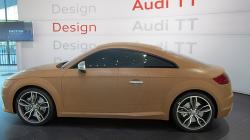 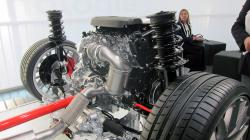 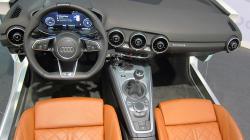 2015 Audi TT. Click image to enlarge |
We’re shown the clay model that inspired the latest TT – a process that takes two years and a team of selected designers to refine. From sketch to CAD drawing to final “optic” clay model, there is “always a human being behind it”. Each component of the car is handcrafted and the model is viewed in natural light in an open courtyard before moving ahead.
The new car is the shortest version of the MQB platform at 2,505 mm, but is 37 mm longer than its predecessor. Like the previous car, it’s built on a version of Audi’s space frame – a mostly aluminum shell with hot stamped, high-strength steel forming floors and bulkhead. This, along with other weight-saving measures, helps shave 50 kg off the TT’s weight, while making it 23 percent stiffer.
While other markets will receive a diesel, possibly in a front-wheel drive configuration, North American models will feature the 2.0L TFSI with a power bump to 230 hp and 273 lb-ft of torque. The TTS-badged cars have been tweaked to produce 310 hp and 280 lb-ft with a 0–100 km/h time of 4.7 seconds. Details on the possibility of the potent TT RS are as yet unavailable.
It’s possible we’ll get a six-speed manual gearbox, however it’s unlikely we’ll receive the front-wheel-drive models available to Europe. North Americans will be restricted to a reworked version of the Quattro all-wheel-drive system and six-speed S tronic transmission.
Inside is a much more sophisticated cabin than TTs past, devoted not only to driver comfort, but convenience and simplicity. Where the original 1995 TT show car boasted only a tape deck and CD player, the new TT has two 64-GB SD card slots and an 11-GB hard drive.
The designers refer to the new cockpit as “tidy minimalism – a symbiosis of tech and design” providing a sporting driver interface.
The heart of this is the virtual display – a 12.3-inch hexagonal display that Audi describes as the new benchmark – providing 1,440 x 540 resolution via two Nvidia processors. [Yeah, but can it run Crysis? –Ed.]
The display incorporates gauges, relevant information and navigation guidance rendered in beautifully crisp colour.
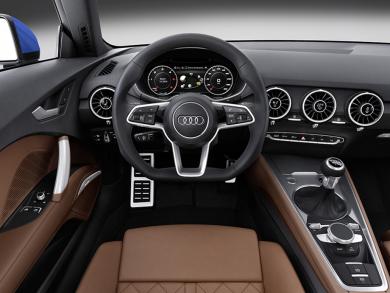 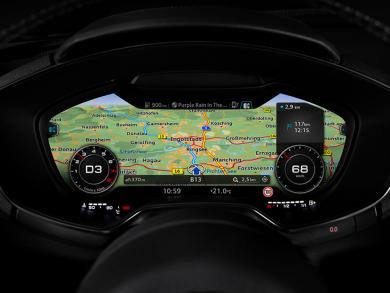 2015 Audi TT. Click image to enlarge |
The redesigned MMI system has been greatly streamlined, cutting out the endless shuffling through pages in an effort to reduce driver distraction. There’s easy-to-use voice recognition, and the main control knob is now touch-sensitive –using a finger, the driver can scribble the first couple of letters and the system uses optical recognition for quick access to phone lists, destinations or favourite genres of music.
Advanced headlights are an integral part of the premium German auto market. BMW is developing a laser system and Mercedes-Benz has come up with one that swivels to follow bends in the road and illuminate pedestrians and obstacles.
Audi has countered with its new “Matrix” LED lighting system which functions similarly, but has no moving parts. Comprised of some 25 different segments containing small diodes, lenses and reflectors, these slick headlights automatically deactivate certain portions when oncoming traffic is detected. Like the Mercedes system, the Matrix headlights work with the car’s sensors, cameras and GPS systems to warn of pedestrians and animals at night, and to anticipate corners and adapt accordingly.
|
Related Articles: Manufacturer’s Website: Photo Gallery: |
Brilliant, right? (No pun intended)
But just like the Mercedes-Benz system – these intuitive new headlights aren’t legally approved in North America. It seems almost ludicrous that a safety innovation with no apparent downside wouldn’t be welcomed with open arms – but that’s what happens when innovations move faster than lumbering bureaucracy.
As consolation there are some 15 driver-assist systems on board, including adaptive cruise control, lane assist, park assist, night vision and head-up display. We’ll retain the current LED headlights with automatic cornering.
There’s no word yet on pricing. While the TT is likely to arrive in Europe late fall as a 2015 model, it will probably get here sometime late next spring – perhaps as a 2016.











